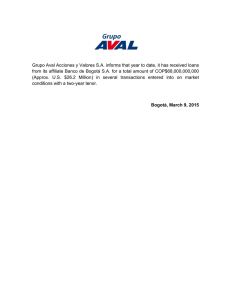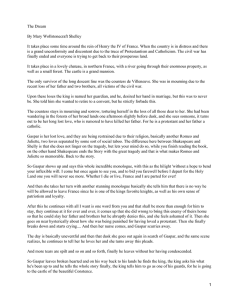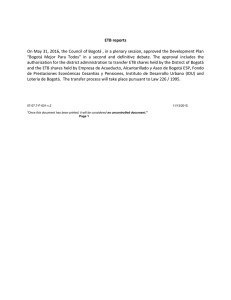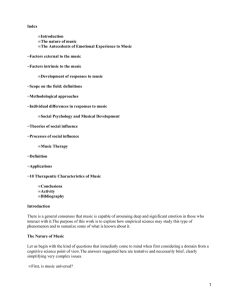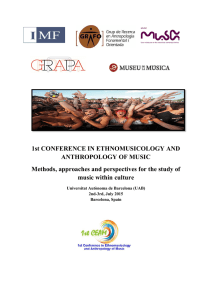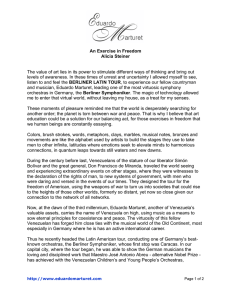MEMORY OF THE WORLD REGISTER American Colonial
Anuncio
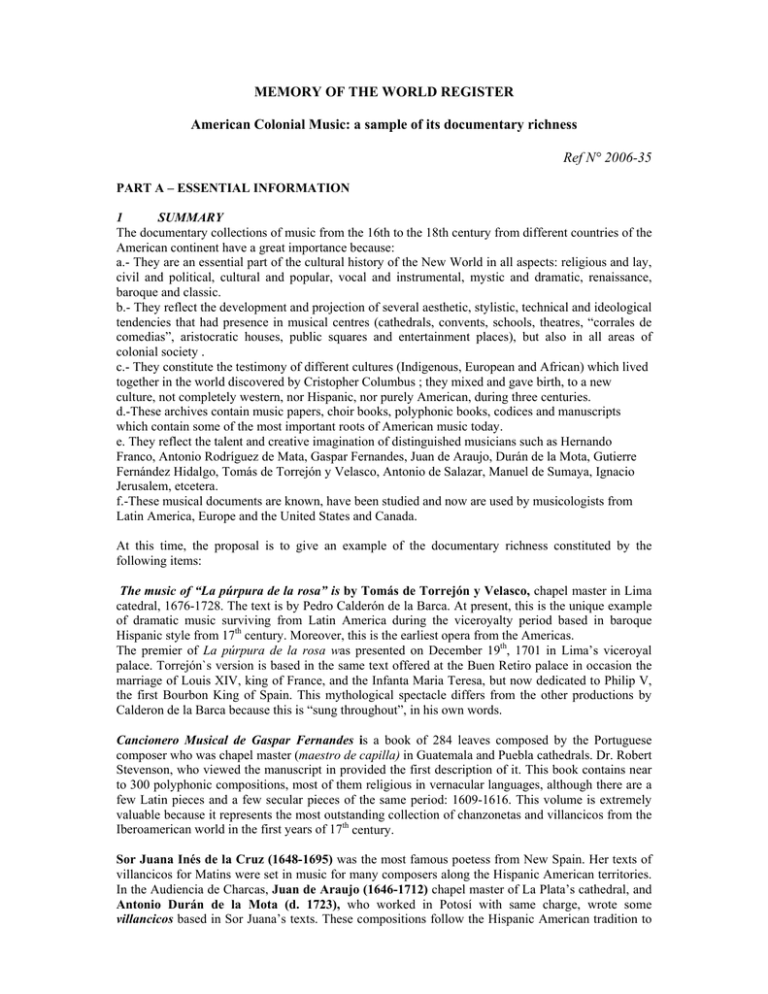
MEMORY OF THE WORLD REGISTER American Colonial Music: a sample of its documentary richness Ref N° 2006-35 PART A – ESSENTIAL INFORMATION 1 SUMMARY The documentary collections of music from the 16th to the 18th century from different countries of the American continent have a great importance because: a.- They are an essential part of the cultural history of the New World in all aspects: religious and lay, civil and political, cultural and popular, vocal and instrumental, mystic and dramatic, renaissance, baroque and classic. b.- They reflect the development and projection of several aesthetic, stylistic, technical and ideological tendencies that had presence in musical centres (cathedrals, convents, schools, theatres, “corrales de comedias”, aristocratic houses, public squares and entertainment places), but also in all areas of colonial society . c.- They constitute the testimony of different cultures (Indigenous, European and African) which lived together in the world discovered by Cristopher Columbus ; they mixed and gave birth, to a new culture, not completely western, nor Hispanic, nor purely American, during three centuries. d.-These archives contain music papers, choir books, polyphonic books, codices and manuscripts which contain some of the most important roots of American music today. e. They reflect the talent and creative imagination of distinguished musicians such as Hernando Franco, Antonio Rodríguez de Mata, Gaspar Fernandes, Juan de Araujo, Durán de la Mota, Gutierre Fernández Hidalgo, Tomás de Torrejón y Velasco, Antonio de Salazar, Manuel de Sumaya, Ignacio Jerusalem, etcetera. f.-These musical documents are known, have been studied and now are used by musicologists from Latin America, Europe and the United States and Canada. At this time, the proposal is to give an example of the documentary richness constituted by the following items: The music of “La púrpura de la rosa” is by Tomás de Torrejón y Velasco, chapel master in Lima catedral, 1676-1728. The text is by Pedro Calderón de la Barca. At present, this is the unique example of dramatic music surviving from Latin America during the viceroyalty period based in baroque Hispanic style from 17th century. Moreover, this is the earliest opera from the Americas. The premier of La púrpura de la rosa was presented on December 19th, 1701 in Lima’s viceroyal palace. Torrejón`s version is based in the same text offered at the Buen Retiro palace in occasion the marriage of Louis XIV, king of France, and the Infanta Maria Teresa, but now dedicated to Philip V, the first Bourbon King of Spain. This mythological spectacle differs from the other productions by Calderon de la Barca because this is “sung throughout”, in his own words. Cancionero Musical de Gaspar Fernandes is a book of 284 leaves composed by the Portuguese composer who was chapel master (maestro de capilla) in Guatemala and Puebla cathedrals. Dr. Robert Stevenson, who viewed the manuscript in provided the first description of it. This book contains near to 300 polyphonic compositions, most of them religious in vernacular languages, although there are a few Latin pieces and a few secular pieces of the same period: 1609-1616. This volume is extremely valuable because it represents the most outstanding collection of chanzonetas and villancicos from the Iberoamerican world in the first years of 17th century. Sor Juana Inés de la Cruz (1648-1695) was the most famous poetess from New Spain. Her texts of villancicos for Matins were set in music for many composers along the Hispanic American territories. In the Audiencia de Charcas, Juan de Araujo (1646-1712) chapel master of La Plata’s cathedral, and Antonio Durán de la Mota (d. 1723), who worked in Potosí with same charge, wrote some villancicos based in Sor Juana’s texts. These compositions follow the Hispanic American tradition to insert songs in popular style into the liturgical services. The circulation of these texts and their use, are the incontestable proof of the renown of the Mexican nun. Araujo and Durán de la Mota wrote their villancicos with great freedom and imagination. Four villancicos by Juan de Araujo –Por celebrar del infante, Venid, mortales venid a la audiencia, Los que tienen hambre and Si Dios se contiene en el sacramento– and three villancicos by Durán de la Mota –Dios y Joseph apuestan, Fuego, fuego que el templo se abrasa y Queditito airecillos– conform a little corpus of pieces representing one of the summits of the colonial culture of Bolivia, a little sample of the musical richness of the Colonial epoch. At the same level the Tomás Luis de Victoria’s music and the works by Gutierre Fernández Hidalgo are considered the best polyphonic pieces from 16th century in South America. The most part of them are integrated in a beautiful “libro de coro” choir book. It contains several vespers Psalms, a set of Magnificats in all Ecclesiastic tones. According to the dates written in the book, Gutierre Fernández Hidalgo was chapel master in Cusco, Quito, Bogotá and Charcas when died. The book is dated in 1584. It is one of the earliest South American (Colombia) cathedral choir book and reflects the repertoire used in the evangelization century. Fernández Hidalgo can be considered as one of the most sophisticated composers, with the same great qualities as his contemporaries in Spain, Italy, France or Germany. 2 DETAILS OF THE NOMINATOR 2.1 Name (person or organisation) Aurelio Tello Malpartida. Musicologist, composer and researcher of the colonial music from Mexico and Peru. Titular Researcher from the National centre for Research, Documentation and Diffusion of Mexican Music (CENIDIM) of National Institute of Fine Arts. 2.2 Relationship to the documentary heritage nominated Academic person very devoted to the music documentary heritage of Latin America. He is knowledgeable about manuscripts and has published several books and articles about colonial music. 2.3 Contact person (s) Egberto Bermudez National University of Colombia Fundación De Música Musicologist of Latin American Colonial Music [email protected] Carlos Seoane Musicologist. Bolivia [email protected] Marcela Inch Biblioteca y Archivos Nacionales de Bolivia [email protected] Dr. Sinecio López Jiménez Director Nacional Biblioteca Nacional del Perú [email protected] Padre Francisco Reyes Archivo Histórico de la Arquidiócesis de Oaxaca [email protected] 2.4 Contact details (include address, phone, fax, email) Aurelio Tello Escocia 29-109, Col. Parque San Andrés, 04040, México D.F. Phone and fax (52-55) 55445369, [email protected] [email protected] Egberto Bermudez National University of Colombia Fundación De Música Cra. 4A Nº 57-00, Bogotá. Phone (571) 31 29009 [email protected] Arz. Cardenal de Bogotá Pedro Rubiano Sánchez Archivo Musical de Bogotá Santa Fe de Bogotá Colombia Marcela Inch Calvimonte Directora Biblioteca y Archivos Nacionales de Bolivia Calle España 43 Sucre, Bolivia [email protected] Phone (591-4) 6451481 Fax 6461208 Carlos Seoane Biblioteca y Archivos Nacionales de Bolivia Calle España 43 Sucre, Bolivia Dr. Sinecio López Jiménez Director Nacional Biblioteca Nacional del Perú Av. Abancay 4ta. Cuadra s/n Lima 01, Perú. Pone (511) 4289713 Fax 4277331 [email protected] Padre Francisco Reyes Archivo Histórico de la Arquidiócesis de Oaxaca Av. Independencia 700, Centro C.P. 68000, Oaxaca, Oax. México 3 IDENTITY AND DESCRIPTION OF THE DOCUMENTARY HERITAGE 3.1 Name and identification details of the items being nominated 3.1.1. La púrpura de la rosa, music by Tomás de Torrejón y Velasco, text by Pedro Calderón de la Barca (Biblioteca Nacional del Perú / National Library of Peru) 3.1.2. Cancionero musical de Gaspar Fernandes (Archivo Histórico de la Arquidiócesis de Oaxaca / Historical Archive of Oaxaca Archidiocese) 3.1.3. Villancicos by Juan de Araujo and Antonio Durán de la Mota with texts by Sor Juana Inés de la Cruz. (Archivo Nacional de Bolivia / National Archive of Bolivia) 3.1.4. Libro de coro (choir book of Polyphony) by Gutierre Fernández Hidalgo (Archivo de música de la catedral de Santa Fe de Bogotá / Musical Archive. Cathedral Santa Fe de Bogotá.) 3.2 Description 3.2.1. Tomás de Torrejón y Velasco’s surviving score, bound in yellowed parchment consist of 89 oblong pages (21 by 34 cm). Copied on one side only, the manuscript catalogued under call number C1469 at the Biblioteca Nacional in Lima, Perú, begins with a splendid title page, continues with three blank leaves, 11 unnumbered leaves comprising the Loa, 55 leaves devoted to all the solo pieces (tonadas solas) in the main body of the comedy, and concludes with 19 given over to choral selections and vocal ensambles. La púrpura de la rosa, boasts a text of great literary quality and sophistication with wonderful plot features including mythical gods and goddesses, love triangles, low-comic relief and the final triumph of love over destiny. Torrejón's music is full of the lively rhythms of Hispanic-American dances, and supports the libretto's description of mountains, gardens, grottos, magic mirrors and flying gods. Since the manuscript was found in 1944, several musicologists have been interested in La púrpura de la rosa. The first modern edition was prepared by Robert Stevenson from UCLA and was sponsored by Organization of American States and Instituto Nacional de Cultura from Peru. Andrés Sas, Lauro Ayestarán, who was one of the first to do the musical transcription of the manuscript. Donald Cruickshank and Angeles Cardona, and Louise Stein made important contributions to knowledge of this work with other studies, editions and musical transcriptions. All of them consider the original manuscript of La púrpura de la rosa by Tomás de Torrejón y Velasco the first genuinely American contribution to the universal lyric theatre. In 2001, when the musical and cultural worlds commemorated the tricentennial of its composition, the National Congress of Peru declared La púrpura de la rosa by Tomás de Torrejón y Velasco y Pedro Calderón de la Barca “Patrimonio Cultural de la Nación” (Cultural heritage of the nation) 3.2.2. The Cancionero musical de Gaspar Fernandes is a book of 284 leaves/folios. It was catalogued by Professor Tello. It has no register number in the Archivo Histórico de la Arquidiócesis de Oaxaca. Its surviving bad conditions were changed after the restoration process. The Cancionero Musical de Gaspar Fernandes is the only book which synthesizes the change from Renaissance to Baroque in the Hispanic Empire, the mixing of cultures living together with others in New Spain territory, the development of a polyphonic style in New World, the assimilation of popular elements in music composition for cathedrals; the course that music was following between the 16th and 17th centuries, with musical elements contributed by African, American and European peoples. On the other hand, the Cancionero Musical de Gaspar Fernandes continued the Iberian tradition of collecting polyphonic pieces in one volume called “cancionero”, such as Cancionero Musical de Palacio, Cancionero de Uppsala, Cancionero de Medinacelli or Cancionero de La Colombina. But these are lay songbooks, whereas the Cancionero Musical de Gaspar Fernandes is mainly religious for use in liturgical services in the Puebla cathedral. The Cancionero passed to Oaxaca because Fernandes’ former pupil, the singer Gabriel Ruiz de Morga, carried it with him. The repertoire consists in several types of villancicos and Latin pieces: Spanish villancicos, Indian or mestizo villancicos, negros, guineos and negrillas, ensaladas, coloquios, two masses, any psalms and some instrumental pieces. With respect to all the books and collections of polyphonic music in the Hispanic American area, the Cancionero Musical de Gaspar Fernandes is the only one that can be called a Latin American “cancionero”. This book is important in various fields: musical of course, but historical, cultural, anthropological and aesthetic also, because it contributes to our knowledge of all the aspects that built American culture. 3.2.3. Villancicos by Araujo and Durán de la Mota are preserved in separated parts for each voice or instruments, in papers of 22 x 17 cm approximately. Despite the vicissitudes of time, the manuscripts remain remarkably coherent. 3.2.4. Libro de coro (choir book of Polyphony) by Gutierre Fernández Hidalgo could be called Vesper Psalms Book, is formed by 204 pages, in fair state of conservation and it is bound in yellowed parchments of 28 x 49 cm. Bibliografía: Stevenson, Robert: The music of Perou: Aboriginal and Viceroyal Epochs, Washington, OEA, 1960. Claro Valdés, Samuel: Antología de la Música Colonial en América del Sur, Santiago, Universidad de Chile, 1974. Stevenson, Robert: La púrpura de la rosa, Tomás de Torrejón y Velasco, Lima, INC, OEA, 1976. Stein, Louise K.: Tomás de Torrejón y Velasco y Juan Hidalgo, La púrpura de la rosa, Fiesta cantada, ópera en un acto, Madrid, ICCMU, 1999. Stevenson, Robert: Renaissance and Baroque Sources in the Americas, Washington, OEA, 1970. Stevenson, Robert: Latin American Colonial Music Anthology, Washington, OEA, 1975. Querol, Miguel: Cancionero musical de Lope de Vega, Tomo III, Poesías cantadas en las novelas, Barcelona, CSIC, 1976. Tello, Aurelio: Archivo Musical de la Catedral de Oaxaca, Catálogo, México, CENIDIM, 1990. Snow, Robert: Gaspar Fernandes, Obras sacras, Lisboa, Fundación Calouste Gulbenkian, 1990. Tello, Aurelio, Cancionero Musical de Gaspar Fernandes, Volumen I, Tesoro de la Música Polifónica en México, Vol. X, México, CENIDIM, 2001. Seoane, Carlos, Andrés Eichmann: Lírica colonial boliviana, La Paz, Editorial Quipus, 1993. Tello, Aurelio: “Sor Juana Inés de la Cruz y los maestros de capilla catedralicios o De los Ecos concertados y las acordes músicas con que sus villancicos fueron puestos en métrica armonía”, Pauta, 57-58, ene-jun, 1996, pp. 5-26 Perdomo Escobar, José Ignacio: El archivo musical de la catedral de Bogotá, Bogotá, Publicaciones del Instituto caro y Cuervo, 1976. Referees: Dr. Ismael Fernández de la Cuesta Real Conservatorio de Música de Madrid [email protected] Dr. Gabriel Garrido Centro de Música Antigua de Ginebra [email protected] Dr. Craig Russell California Polytechnic [email protected] Dr. Drew Davies Chicago University [email protected] Dr. Grayson Wagstaff Catholic University Benjamin T. Rome of Washington [email protected] 4 JUSTIFICATION FOR INCLUSION/ ASSESSMENT AGAINST CRITERIA 4.1 Authenticity Several musicologists have confirmed the authenticity of these documents. Dr. Lauro Ayestarán made one the first musical transcriptions of La púrpura de la rosa’s manuscript; Dr. Robert Stevenson published the score in 1971; Donald Cruickshank and Angeles Cardona published the text and the score in Germany in 1990, and Drs. Louise Stein published a new edition of the score in Spain in 1992. All of them saw the manuscript and it has been compared with the first editions of the text (Donald Cruickshank) and the musical style by Juan Hidalgo, chapel master of the Royal Court (Drs. Stein), and another musicians and composers of the same period (second part of the 17th century). Dr. Robert Stevenson and Aurelio Tello have been studying for many years the Gaspar Fernandes manuscript. Professor Tello called it the Cancionero Musical de Gaspar Fernandes because he wrote an essay comparing this book with other similar books from Spain and Portugal. Dr. Stevenson made the first list of pieces included in the book, but Professor Tello has been working since 1999 on the critical edition of the manuscript. Well known musicologists like Carmen García Muñoz, Waldemar Axel Roldán, Samuel Claro Valdés, Carlos Seoane and, of course, Dr. Stevenson studied the manuscripts by Araujo and Durán de la Mota and they include some villancicos and other latin pieces in their publications with colonial music. In recent years Aurelio Tello and Bernardo Illari made new contributions about Sor Juana’s villancicos and Professor Tello established the link between Araujo y Durán and Sor Juana. For his part, Professor Illari transcribed the music for recording project with Ensamble Elyma. The Choir book of Polyphony by Gutierre Fernandez Hidalgo is one of many marvellous choir books preserved in Latin American cathedrals, but in Bogotá specially. Dr. Robert Stevenson and José Ignacio Perdomo Escobar saw the book around 1960 and each one made laudatory notes about it. 4.2 World significance, uniqueness and irreplaceability La púrpura de la rosa manuscript is the sole opera in baroque Hispanic style existing in Latin America. This piece is conserved in Department of Research, Rare books and Manuscripts of National Library of Peru. Dr. Robert Stevenson called to Cancionero de Gaspar Fernandes “the most spectacular treasure of any cathedral in the Occidental world”. Villancicos by Araujo and Durán are rare samples of poems by Sor Juana set in music as can be seen in the “pliegos sueltos” she wrote his texts for singing. Unique book showing the Fernández Hidalgo music is the Choir book of Polyphony. The loss of such treasures would be a serious damage for the cultural heritage of the Hispanic American and the international musical heritage. 4.3 Criteria of (a) time (b) place (c) people (d) subject and theme (e) form and style a) Time. These documents cover three centuries of musical life. The Choir book of Polyphony by Fernández Hidalgo includes pieces composed around 1584. The Cancionero Musical de Gaspar Fernandes can be located between 1609-1616. Villancicos by Araujo and Durán de la Mota belong to the second half of the 17th century. La púrpura de la rosa by Torrejón y Velasco and Calderón de la Barca is a great testimony of the music song and played with representational character in the Golden Century, along the seventeenth century, although was composed in 1701. b) Place In all senses, Lima, Puebla (where the Gaspar Fernandes manuscript was copied), La Plata or Chuquisaca and Bogotá were very important musical places in Colonial period. It explains the composition of La púrpura de la rosa by Torrejón y Velasco, who received the commission of Conde de Lemos, viceroy in Peru, to celebrate the first year of kingdom and the 18th anniversary of Philip V’s birthday. The performance lasted for four days in the Viceroyal palace, which was an important cultural centre too. c) People Tomás de Torrejón y Velasco was born in Villarrobledo, Albacete (near to Madrid) in 1644. He moves to Peru in 1667, when Peruvian viceroy Pedro Fernández de Castro y Andrade, Conde de Lemos was appointed. At this time, Torrejon became a page in the Fernández de Castro household. His cathedral career brought him much satisfaction in seeing his works in print at Antwerp in 1688, in Lima in 1701, 1708 and 1725. His musical opinions were solicited at Cusco and Trujillo, and other cities with important cathedrals. His works were sought as far away as Guatemala, where no less than twelve villancicos survive. On 11November 1680, the same day that saw the inauguration of the second great organ, he created a surprise with eight villancicos composed to celebrate the beatification of Toribio de Mogrovejo. On June 26, 1701, he greatly moved the public with new memorial music composed for the vespers of the recently deceased Charles II. A few months later, Torrejón was commissioned by the viceroy Melchor Portocarrero Laso de la Vega, Conde la Monclova, to write festive music in honour of Philip V. In 1708 the Peruvian writer Pedro de Peralta y Barnuevo placed Torrejón on an equal footing with his best-known peninsular musical contemporary, Sebastián Durón. His music was performed in Lima, Trujillo, Cusco, La Plata (Bolivia) and Guatemala cathedrals. Pedro Calderón de la Barca is most well known Spanish dramatist of 17th century. His works were played in Hispanic American territories and he influenced many writers in Mexico or Peru, as is known in the case of Sor Juana Inés de la Cruz. Gaspar Fernandes was a Portuguese composer. He was born in Evora (c.1570) but he moved to Guatemala and later to Puebla. In this city he was appointed chapel master of the cathedral. He occupied this post until his death in 1629. His music reveals a deep knowledge of great masters of polyphonic style. He was the first great composer of Golden Century in Puebla de los Angeles. Some of the most interesting compositions are devoted to Diego Fernández de Córdoba, 13th viceroy of Mexico, composed in October 1612. Juan de Araujo (1646-1712) was born in Villafranca, Spain. He was active in Lima (in 1670 he was appointed chapel master), Cusco and La Plata (now Sucre) where he was chapel master between 16801712. He was a prolific composer and his music was performed in Lima, Charcas, Cusco, Panamá, La Paz, Montevideo and Jesuit missions in Moxos. Antonio Durán de la Mota is the most important composer from Potosí during first years of 18th century. In 1716, he composed the music for Fray Diego Morcillo de Rubio y Auñón’s consecration as bishop of Potosí. When Araujo was died in 1712, Durán de la Mota did not accept the post in La Plata. His works are preserved in La Paz y Cusco. Gutierre Fernández de Hidalgo was born in Spain c.1547 and is very important because he was the first Spanish composer to be established in South America. He promoted European cultural music in Colombia, Ecuador, Perú and Bolivia. d) Subject. The main subject of these manuscripts is music. La púrpura de la rosa is the best example of theatrical music (opera) in Hispanic American in the 17th century; an opera in all senses, composed with great originality and very distinctive aspects which demonstrated the composer’s genius. Cancionero Musical de Gaspar Fernandes reveals the development of the villancico in the New World. Villancicos by Juan de Araujo and Antonio Durán de la Mota with texts by Sor Juana Inés de la Cruz are the proof that this poetic-musical genre became a mature form of expression. Choir book Polyphonic by Gutierre Fernández Hidalgo demonstrates the great musical depth of our cathedrals during 16th century Issues of rarity, integrity, threat and management All these materials are rare, unique and irreplaceable. Most of them are in an acceptable state, lthough some of them (La púrpura de la rosa, parts of the Cancionero Musical de Gaspar Fernandes or Bolivian manuscripts) suffered damage or mutilation by misuse and inadequate conditions before being placed in the actual institutions where are conserved. At present, the Cancionero Musical de Gaspar Fernandes has been restored and is preserved in the best conditions possible. 5 LEGAL INFORMATION 5.1. Owner of the documentary heritage (name and contact details) La púrpura de la rosa Biblioteca Nacional del Peru. Dr. Sinecio López, Director Nacional Biblioteca Nacional de Perú Ave. Abacay 4ta.Cuadra s/n Lima, 01 Perú [email protected] Tel. (511) 4289713 and 4287690 Ext.101 or 102 Cancionero musical de Gaspar Fernández Archivo Histórico de la Arquidiócesis de Oaxaca Padre Francisco Reyes, Responsable del archivo Berenice Ibarra, archivera Av. Independencia 700, Centro C.P. 68000, Oaxaca, Oax. México Villancicos by Juan de Araujo and Antonio Durán Texts by Sor Juana Inés de la Cruz Archivo Nacional de Bolivia Lic. Marcela Inch, Directress Calle España 43 Sucre, Bolivia Phone (5914)6451481 Fax 6461208 [email protected] Libro de coro by Gutierre Fernández Hidalgo Arz. Cardenal de Bogotá Pedro Rubiano Sánchez Archivo Musical de Bogotá Santa Fe de Bogotá Colombia Contact: Egberto Bermúdez [email protected] 5.2 Custodian of the documentary heritage (name and contact details, if different to owner) The custodian of the documents are the same institutions 5.3 Legal status: (a) Category of ownership Biblioteca Nacional del Perú is a public institution and depends of Education Ministery. Archivo Histórico de la Arquidiócesis de Oaxaca belongs to Catholic Church. Archivo y Biblioteca Nacionales de Bolivia is a public institution. Archivo de la Catedral de Bogotá belongs to Catholic Church. (b) Accessibility In all institutions it is possible to consult the musical manuscripts under certain rules. (c) Copyright status If this point is referred to copyright, since all of them are manuscripts from the 16th, 17th and 18th centuries, no copyright or intellectual property are applicable. (d) Responsible administration Each institution is legally responsible for the safe keeping of the materials (e) Other factors The national institutions and the churches by law must preserve the documentary heritage 6 MANAGEMENT PLAN 6.1 The institutions have their management plans to preserve the documents, but they need some courses in preventive documentary preservation and restoration. 7 CONSULTATION 7.1 Provide details of consultation about this nomination with (a) the owner of the heritage (b) the custodian (c) your national or regional Memory of the World committee See # 2 and 5.1 Comité Mexicano Memoria del Mundo (CMMM) Chair: Rosa Maria Fernández de Zamora [email protected] Comité Regional de América Latina y el Caribe Para el Programa memoria del Mundo (CRALC-MOW) Chair: Margarita Vannini [email protected] PART B – SUBSIDIARY INFORMATION 8 ASSESSMENT OF RISK 8.1 Each institution has a security system against risks. 9 ASSESSMENT OF PRESERVATION 9.1 Some of these documents are available in modern editions or in microfilm, La púrpura de la rosa, or Cancionero Musical de Gaspar Fernandes for example, but the digitizing of these documents could be convenient. PART C - LODGEMENT This nomination is lodged by: (Please print name)… Mtro. Aurelio Tello Malpartida……………………………………………………………….. (Signature)…………………… (Date) March 30, 2006………………………………………
